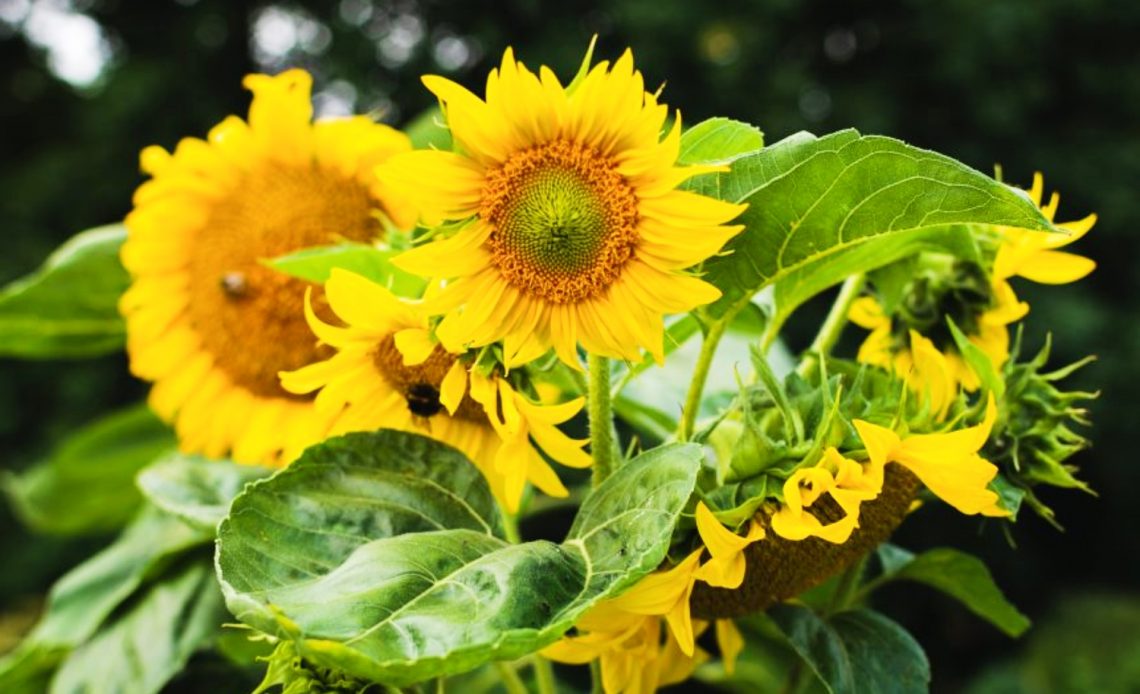

We’re here to help! Wild Yards is a completely free website that is 100% dedicated to helping you create a wildlife-friendly, sustainable yard. Read more
WildYards is reader-supported. When you buy a product through a link on our site, we may earn a comission. Every product is independently selected by our (obsessive) editors and our reviews are unbiased and objective. Read more about our mission or our privacy policy.
Beloved for its bright, sunny open face and cheery appearance, the sunflower is a popular annual that is as functional as it is beautiful.
Sunflowers attract valuable pollinators, including butterflies, hummingbirds, and bees.
Once the flowers have been pollinated, the plant’s seeds can be used in cooking, or left to feed your local songbirds.
In general, sunflowers are very easy to grow. But they can run into a few troubles.
If you’ve noticed your sunflower leaves turning yellow, you may wonder why, and, more importantly, what you can do to help the plant recover.
Sunflower leaves often turn yellow in response to overwatering and poor drainage. Improving drainage and reevaluating your watering schedule is often enough to help plants improve.
8 Reasons why your sunflower leaves are turning yellow, plus what you can do to fix it
One of the reasons why people love sunflowers so much is because they’re so easy to care for. But if your sunflower’s leaves are looking a little sickly, you’ll need to figure out why or the plant may not survive.
Sunflower leaves turn yellow for a few reasons. And if you act fast, you can help the plants recover.
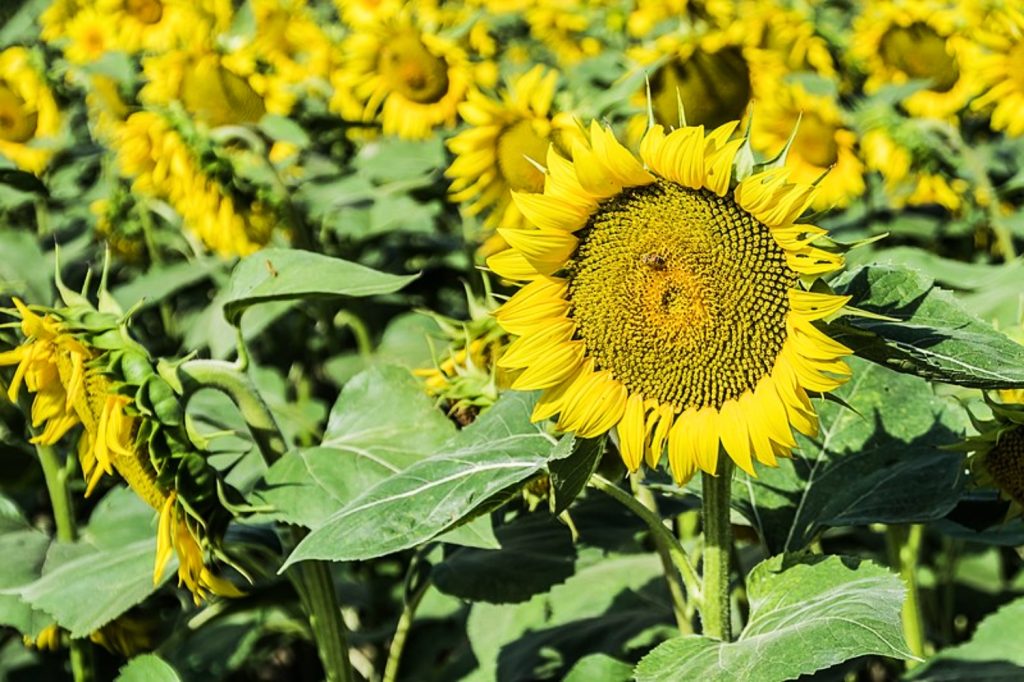
The problem: Overwatering
The most common reason why sunflower leaves turn yellow is overwatering. Sunflowers are particularly susceptible to overwatering. They do not like it when their roots are sitting in muddy soils.
If left to sit in puddles, sunflower leaves may turn yellow. A good sign that your sunflowers have been overwatered is when their lower leaves start turning yellow, then brown and falling off.
Check the soil surrounding your sunflowers. If you see water standing, that’s an indicator the plants aren’t getting enough oxygen because the soil is waterlogged.
Sunflowers prefer to grow in sandy to sandy loam soils. If your soil is clay-rich, it may not “breathe” enough to suit your sunflower’s liking.
The solution: Scale back on watering and improve drainage
If you’ve determined that your sunflowers have been overwatered, there are two things you need to do.
First, stop watering them. Let the soil dry out well in between waterings to give the plants a chance to absorb oxygen.
Next, improve soil drainage if necessary.
Add a healthy measure of sand or potting soil designed for lavender to improve soil structure. This makes the soil more porous, so air can reach the roots and excess water can drain quickly.
If your soil is already sandy, you’ve just received too much rainfall recently, or accidentally left the hose on for too long, then just cut back on watering to give the flowers time to recover.
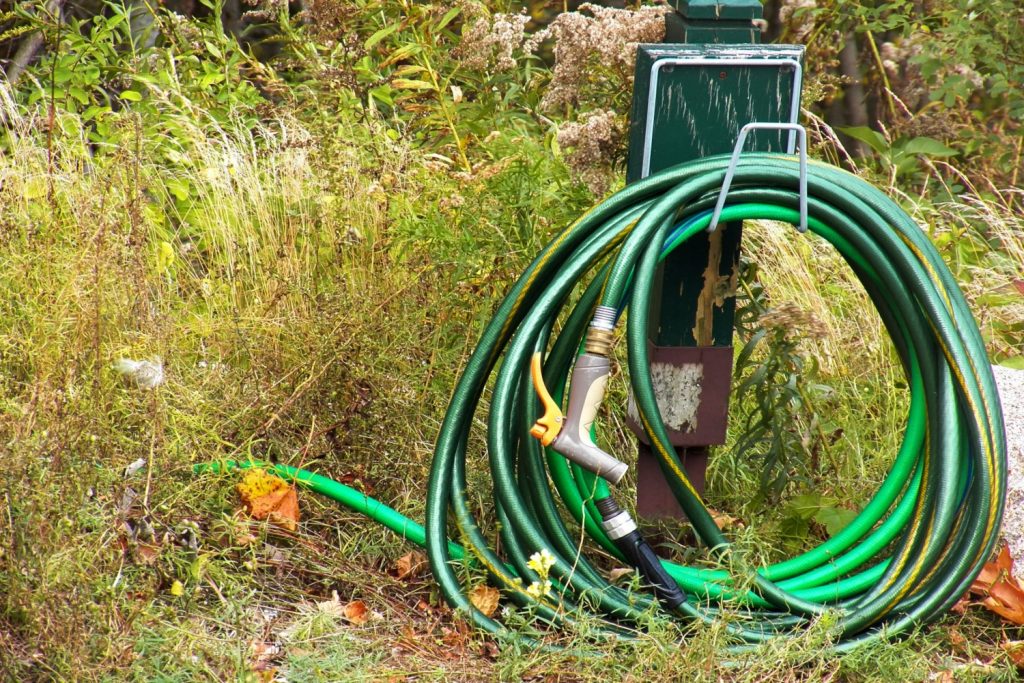
The problem: Underwatering
When sunflower leaves turn yellow, it could also be because they haven’t been watered enough.
Sunflowers grow best in loose, sandy, well-draining soil that can be kept somewhat moist.
Mature sunflowers are somewhat tolerant of dry soils. But seedlings and young plants rely on that moisture to keep growing.
If the soil feels dry an inch below the surface, that’s a good sign your sunflower’s foliage is yellowing because it hasn’t been watered enough.
In addition to yellowing foliage, underwatered sunflowers may wilt and turn brown. Flower heads may go limp, pulling the entire plant over or causing the stalks to snap.
The solution: Give the plants a drink
Sunflowers definitely don’t like sitting in boggy soil. But you shouldn’t let them stay dry for too long, either.
Water your sunflowers regularly, especially while they’re young, to help the roots get established.
Instead of giving the plants small drinks frequently, give them deep drinks less often.
This helps the plants grow deeper, stronger root systems, which doesn’t just enable them to reach more nutrients, but also anchors them and helps keep them upright!
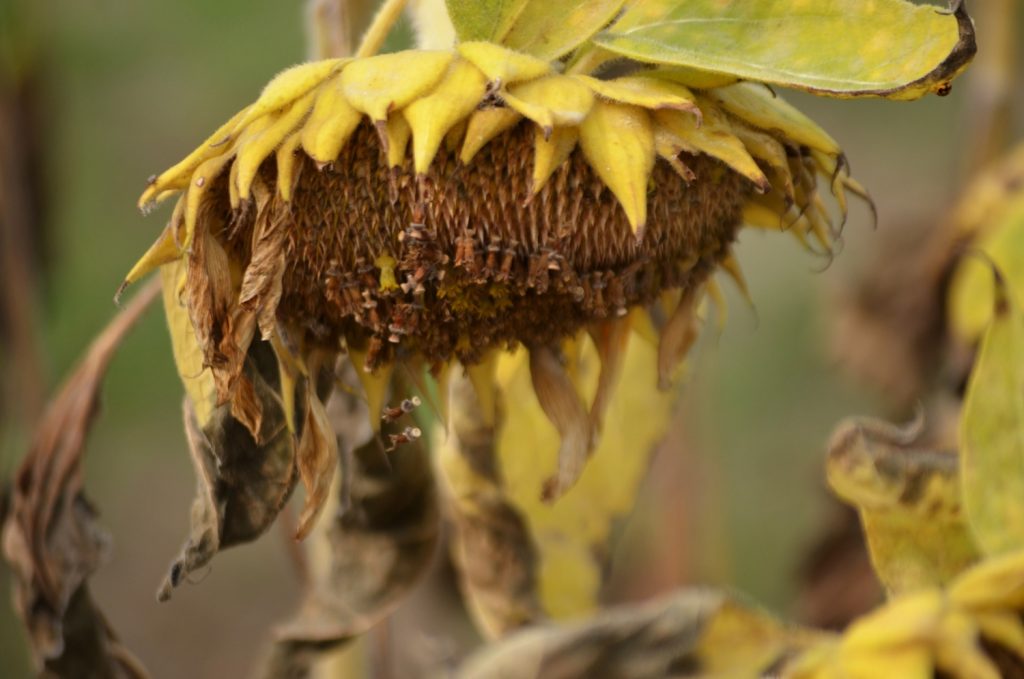
The problem: Extreme heat
Sunflowers grow best in full to partial sunlight. The cooler the environment, the more sun they can handle.
But if your thermometer regularly hits the 90s and 100s, and your sunflowers are growing in full sun, their leaves may be turning yellow because the plants are getting too hot.
Keep an eye on your sunflowers throughout the course of the day.
If the plants are getting 6 or more hours of direct sunlight and haven’t been underwatered or overwatered, then the flowers are probably struggling to deal with the heat.
The solution: Keep the plants cool
In hotter growing zones, you’ll need to make sure your sunflowers get some afternoon shade to shield them from the scorching heat.
Situate your sunflowers on the east side of your home, garage, or shed to give them some protection.
You can also plant sunflowers on the opposite side of your bean crop. Both plants will protect each other from the elements, and attract beneficial pollinators, to boot.
In extremely hot environments, the morning sun is sufficient to meet the light demands of your sunflowers.
If you haven’t got much shade in your backyard, look for heat-tolerant sunflower varieties, like SunBelievable ‘Golden Girl’ and ‘Brown-Eyed Girl’.
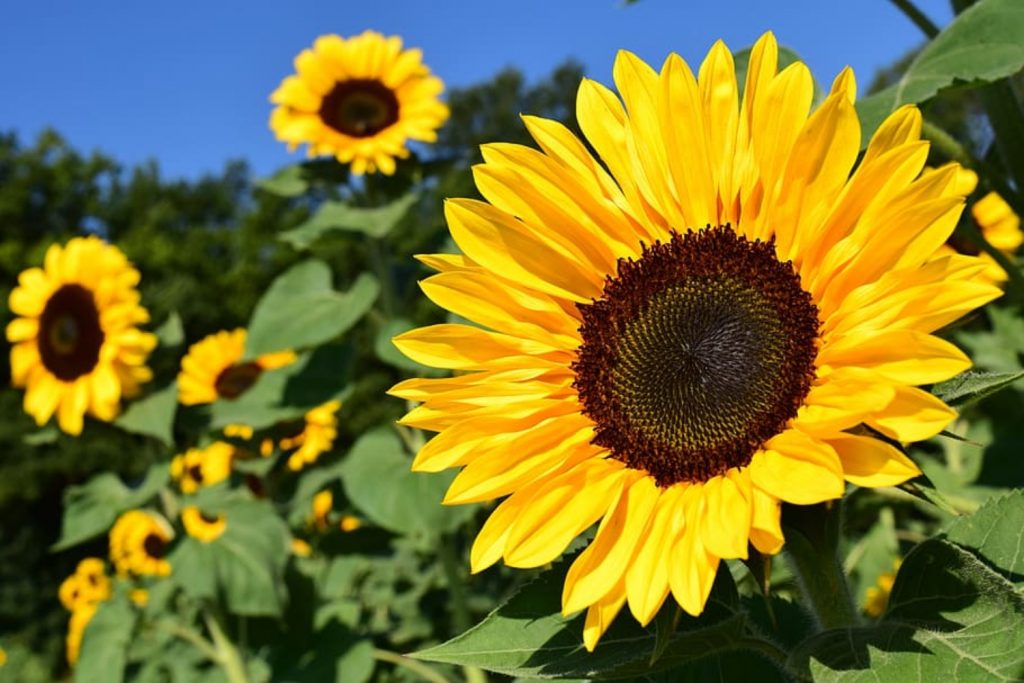
The problem: Nutritional deficiencies
Nutrient deficiencies can also contribute to yellowing foliage in sunflowers.
Low nitrogen levels lead to yellowing foliage and stunted growth. Plants may drop their leaves and new shoots will appear red to brown.
Sulfur deficiency results in similar symptoms. Plants turn yellow starting at the base with the color working its way up. Maturity is delayed and flowers fail to open.
Potassium deficiency is also common, with undersized plants and flowers. Old leaves begin turning yellow and curl upward, with leaves turning brown and crunchy.
The solution: Feed the plants
If you suspect your sunflowers are struggling with a nutritional deficiency, test the soil to determine which minerals the soil is lacking.
Once you know which minerals your sunflowers are deficient in, you can replace them. Naturally, the sooner you replace them, the sooner the flowers will recover.
Ideally, you should test the soil before planting sunflowers — or, well, anything, really! That way, you can amend the soil ahead of time, and give your plants the best start possible.
If your sunflowers lack multiple nutrients, or if you just want to support them as they grow, feed them with a fertilizer designed for roses or one that supports bloom production.
The problem: Garden pests
Beneficial insects aren’t the only ones who love sunflowers. Aphids, spider mites, and other soft-bodied bugs enjoy them, too. And they can make short work of your sunflower crop.
If insects are the cause of your sunflower’s yellowing foliage, take a closer look. Check for leaves with bites taken out of the edges and holes bored into them.
Examine the undersides of the foliage by shining a flashlight through them. Do you see tiny dots moving around?
You may even be able to see the bugs. Look for small red, brown, green, yellow, orange, and/or white specks congregating under the foliage and near the stems.
Moths and butterflies lay their eggs on sunflowers so their larvae can feed on the plants once they hatch. So you may find caterpillars, too.
The solution: Use an insecticide
If your sunflowers are infested with insects, then you’ll need to use an insecticide.
But first, try spraying the plants down with a hose.
Use a sprayer attachment to physically repel insects from the plant’s foliage being sure to spray all sides of the leaves. Use your fingers to gently rub the leaves to break up insect eggs.
Afterward, allow the plant to dry completely, then spray the foliage with a homemade insecticide.
An insecticidal soap dilution or neem oil solution will help keep pesky bugs at bay.
If the infestation is severe, then use diatomaceous earth to sprinkle onto the plants. Diatomaceous earth causes soft-bodied insects to dehydrate within a matter of hours.
Leaves that have turned yellow due to insect infestation may not recover. But by eliminating your bug problem, the plant’s new leaves will appear healthy and green.
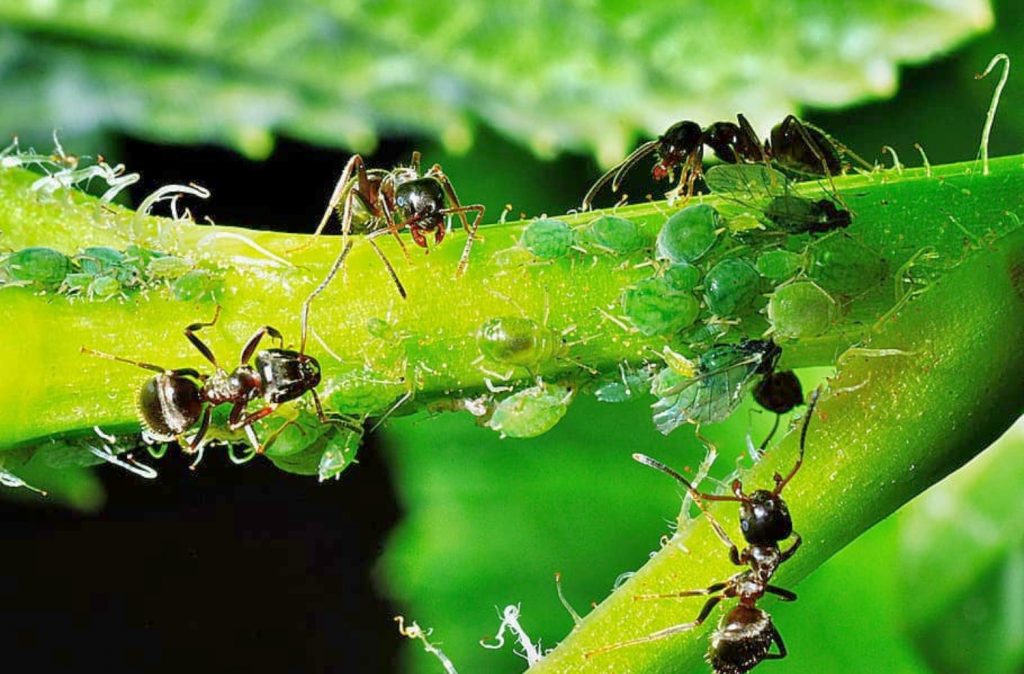
The problem: Fungal infection
If your sunflower’s leaves aren’t turning uniformly yellow, but rather, are developing yellow patches, that points to a fungal infection.
Downy mildew is one of the most common fungal infections to hit sunflower plants. This disease results in yellow and brown spots on the leaves tops and a fuzzy gray coating on the undersides.
Alternaria Leaf Spot is another fungal infection that can cause sunflower leaves to turn yellow. This infection leads to brown to black spots with yellow halos.
The solution: Use a fungicide
Infected sunflowers need to be treated quickly. As with insect infestations, the sooner you treat the plants, the faster they can recover.
To treat fungal infections, make a homemade fungicide.
Add a tablespoon of baking soda and a teaspoon of dish soap to a gallon of water. Use this mixture to treat the plants.
You can also purchase a fungicide if you’d rather. Any broad-spectrum fungicide should do just fine.
Small-scale infections can be treated via pruning.
Simply remove the affected leaves, being sure to spray your pruning shears down with a bleach dilution in between snips, to prevent the infection from spreading.
The problem: Poor air circulation
Lack of air circulation can contribute to yellowing foliage. Poor ventilation leads to an accumulation of humidity. This can cause leaves to yellow, turn brown, and fall off.
It’s also worth noting that poor air circulation can increase a plant’s risk of developing fungal infections.
Like all other plants, sunflowers need adequate airflow to produce strong root systems, durable foliage, and thick, sturdy stems.
Planting sunflowers too close together forces plants to compete for resources, meaning none of the plants can reach their full potential, and only the strongest plants survive.
The solution: Improve ventilation
Be sure to plant your sunflowers in a well-ventilated area.
Sunflowers can grow to be quite tall. The ‘Russian Giant’, for instance, can grow up to 14 feet!
Because they grow so tall, and because they tend to become top-heavy, it’s important to protect them from harsh winds so they don’t snap in half.
That said, plants should be grown in an open, airy location to prevent humidity from getting trapped at the base of the plant.
You should also be sure to give the plants plenty of space to spread out. Keep sunflower plants 12 to 24 inches apart.
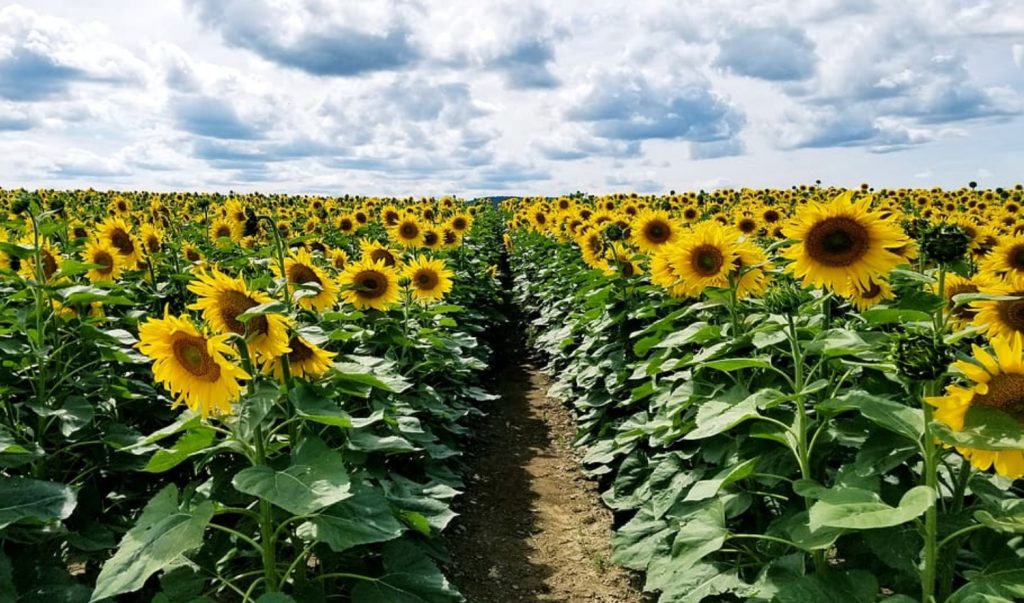
The problem: Natural aging
If your sunflower’s leaves are turning yellow at the end of the growing season, there’s no need to panic. It’s all part of the natural aging process.
After your sunflowers have bloomed and gone to seed, they start to die.
Most sunflowers are annuals, so they die at the end of the season, and new plants grow from seeds to take their place during the next growth cycle.
There are a few perennial sunflower varieties, including willowleaf, thinleaf, and swamp sunflowers. These plants will still lose their leaves before the winter. But they will come back in spring.
The solution: No action is needed
If your sunflowers turn yellow and brown and drop leaves after the flower heads have gone to seed, the plants have reached the end of their lifecycle.
Since most sunflowers are annuals, there’s nothing you can do to revive the plants at this point.
You can, however, collect the sunflower seeds to start new plants next year. Sunflowers are a rich source of nectar for pollinating insects, and they add height to your flower beds to keep your landscaping interesting.
If you’d rather not grow more sunflowers, or if you want to experiment with new varieties next season, leave the seeds and flower heads for your local deer to enjoy, instead.
Once the sunflower stalks have died, you can uproot them and discard them. Consider adding the stalks to your compost heap to feed the plants in your garden later on.
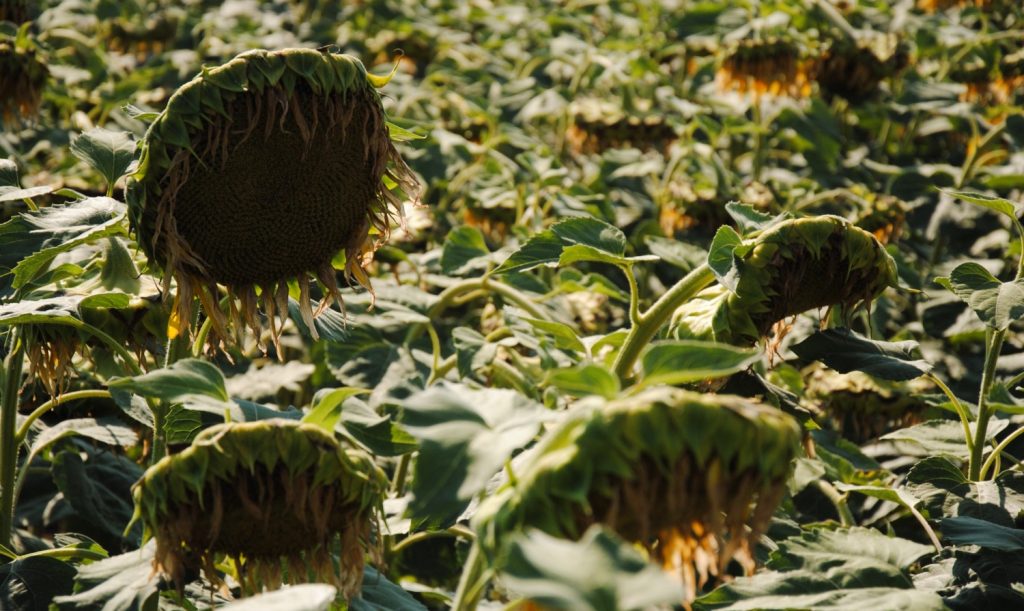
Do yellow sunflower leaves turn green again?
Leaves that have developed a slight yellow tinge may turn green again.
Leaves that have developed yellow spots may still be useful to the plant. The green portions of the leave still enable the plant to absorb sunlight, even if the spots don’t regain their original coloring.
But leaves that are more yellow than green probably won’t recover.
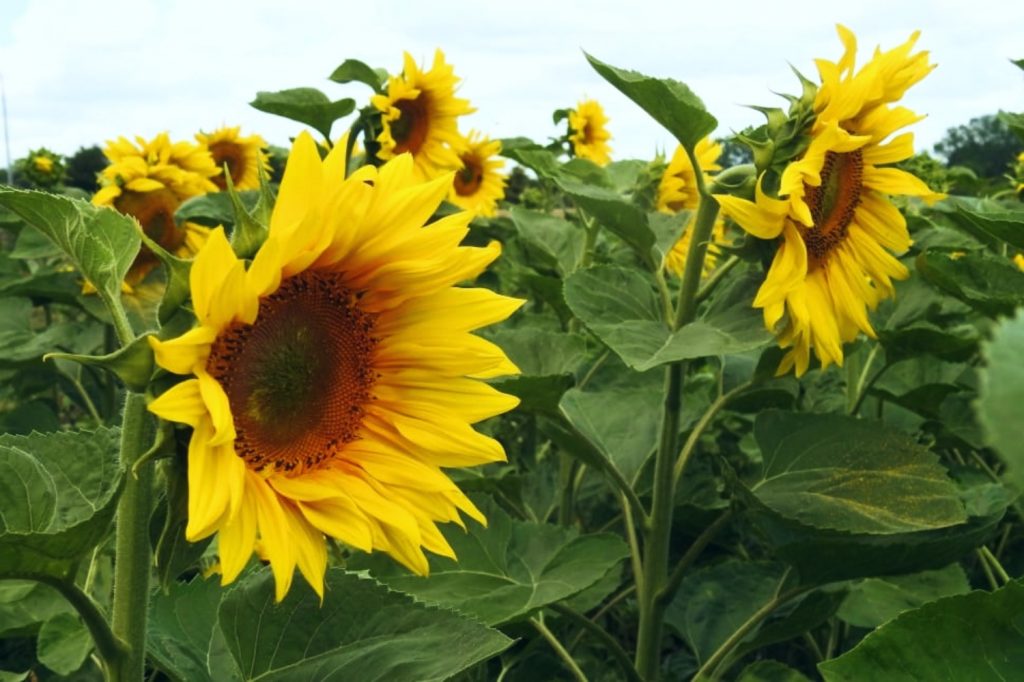
Should you prune the yellow leaves off your sunflower plants?
Leaves that are more than 80% yellow should be removed from the plant.
Yellow leaves that are diseased should also be removed, as should leaves that have turned yellow due to insect infestation.
Trimming away the yellow foliage allows the plants to focus more of their energy on producing new leaves.
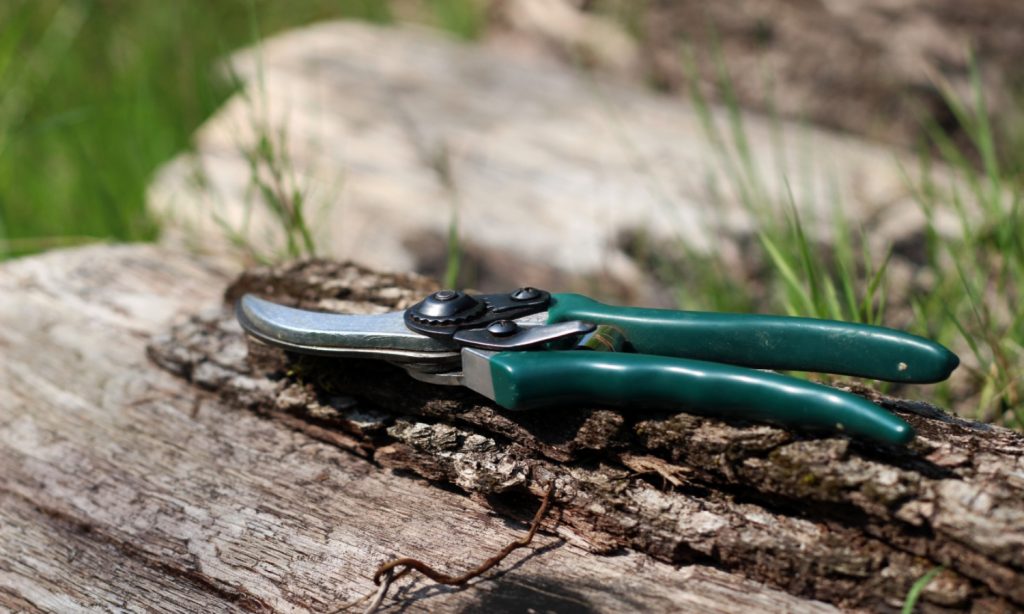
How to grow sunflowers with green leaves
Sunflowers are so much fun to grow. They’re easy to start from seeds, they grow quickly, and their iconic flower heads are the perfect way to prep your backyard for summer.
But, as easygoing as sunflowers are, they still need to be taken care of.
Here are a few more tips that will allow you to grow healthy sunflowers with vivid flowers, strong stalks, and healthy green leaves.
Stake the plants up
Unless you’re growing dwarf sunflowers, you’ll need to make sure to stake up your sunflowers to keep them upright as they grow.
Sunflowers become top-heavy over time. Staking them up improves their shape by allowing their stalks to grow straight.
If your sunflower’s stalk bends or grows crookedly, this interrupts the flow of water, nutrients, and energy to all parts of the plant, which can impede flower and seed production as well as foliage development.
Grow your sunflowers up against a structure or use stakes to give them additional support.
Remove weeds regularly
Weeds compete with sunflowers for nutrients, and, as we know, nutritional deficiencies can contribute to yellowing leaves.
Removing weeds regularly is an easy way to ensure your sunflowers produce beautiful green leaves.
Consider planting creeping thyme or clover to use as a ground cover around your sunflower patch. These plants will carpet between your sunflowers and snuff weeds out before they get a chance to pop up.
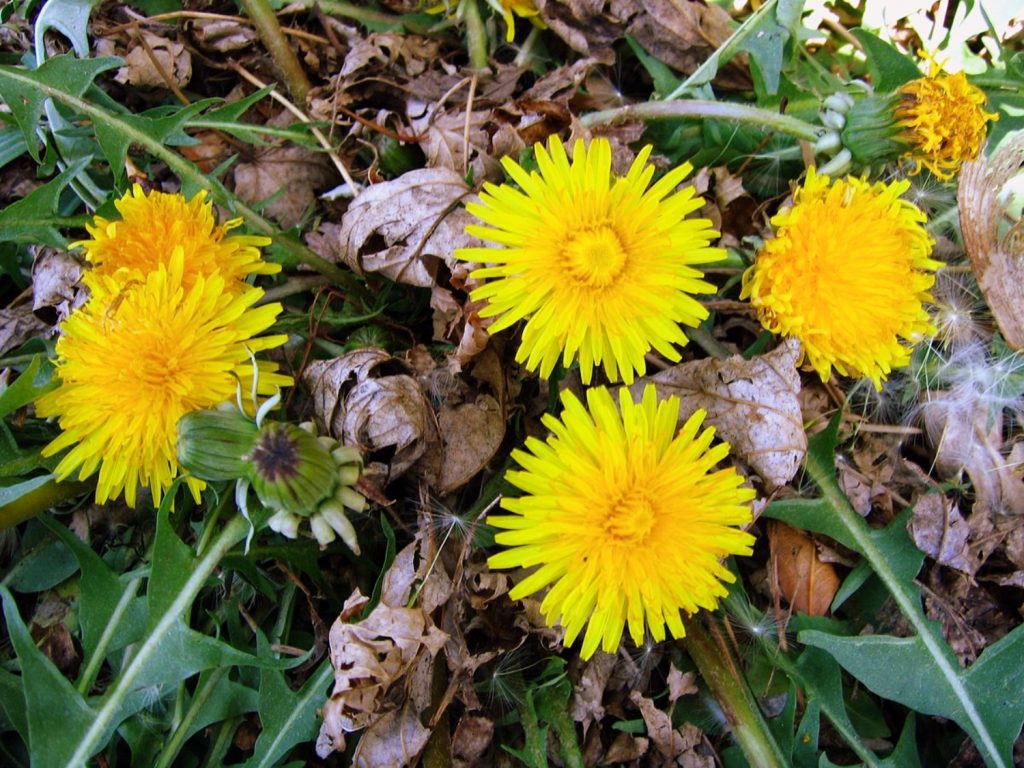
Consider deadheading
Most sunflowers produce one large flower, called a terminal flower, per season. But once that flower has been pollinated, the plant can produce smaller flowers along its stem.
Deadheading your sunflowers helps the plants conserve energy which the plants can then use to make more flowers. Plus, you can use the sunflower heads to make potpourris.
Although these flowers are much smaller than the plant’s original terminal flower, they can still add color to your garden and keep it looking vibrant and happy throughout the season.
Deadheading also helps plants conserve energy to keep their foliage nice and green.
The key to growing healthy sunflowers
Obviously, meeting your sunflower’s growing requirements is the best way to keep the plants healthy. But choosing the right variety is also important.
If you’ve struggled to grow sunflowers in the past because the plants have always fallen prey to insects and diseases, choose resilient varieties like ‘Soraya’ and ‘Sunbright’, or red sunflowers like ‘Claret’.
These sunflower cultivars are known to be resilient against many of the diseases and insects they’re vulnerable to.
By choosing the correct cultivars and meeting all of their light, soil, water, and nutritional needs from the very start, you can grow gorgeous sunflowers with vibrant green foliage to dress up your garden this season.
